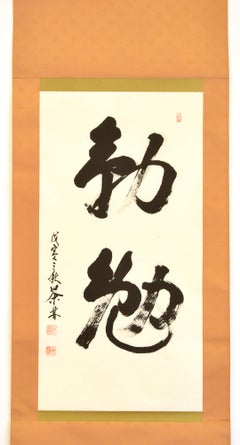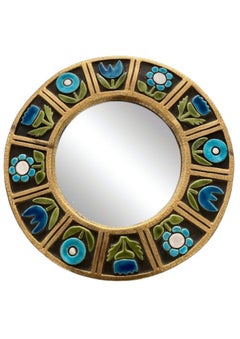Howgego Historic & Modern More Art
to
6
1
Overall Width
to
Overall Height
to
7
5
1
1
3
1
5
2
1
1
1
7
Norman Stuart Clarke Vase Wave Seascape Blue Purple White, 1997
Located in Eversholt, Bedfordshire
Norman Stuart Clarke (b.1944): Seascape, wave vase, 1997
"I use bold, powerful colors; it's a consuming interest of mine, an obsession, placing ...
Category
1990s Modern More Art
Materials
Glass
Lusia Robinson Vase Infinity Fibreglass High Grey Black Brown
By Lusia Robinson
Located in Eversholt, Bedfordshire
Lusia Robinson: Infinity Vase
- This vase is characteristic of Robinson’s work emphasizing materiality within form integrating indigenous materials with modern technology and applic...
Category
1980s More Art
Materials
Fiberglass
Robert Fournier Bottle Stoneware 1960-1965 White Brown Crusty Textured Glaze
Located in Eversholt, Bedfordshire
Robert Fournier (1915-2008), stoneware, tall flattened, bottle, circa 1960-1965
- This bottle is from the same series as No.2008.658.18 in the Metrop...
Category
1960s Modern More Art
Materials
Ceramic
Alan Wallwork Vessel Vase Pottery Sculpture TOTEM White Brown Terracotta
Located in Eversholt, Bedfordshire
Alan Wallwork (1931-2019): Organic landscape sculptural vessel, 1960-1965
-Exhibiting the articulated, inventive, organic qualities & tactility of Wallwork’s early oeuvre for which he is best known - This sculptural landscape vessel has been handmade by coiling, slabbing and shaping the clay. The totemic form and pitted and pierced surfaces draw on the abstract landscape and tactility of elements in nature. matte glazes and oxides have been skillfully used to enhance the rich textures of the surfaces and the organic aesthetic.
- Wallwork is one of the great individualists in British pottery, developing an archetypal language that echoed some of the wider artistic obsessions of that period, what the art critic Herbert Read called the “postwar ferment” of sculptural activity.
- This piece was made during 1960-1965, the time that Wallwork was sharing a studio in Greenwich with Bernard Rooke and comes from a private collection along with a waterscape vase by Rooke and a bottle by Robert Fournier...
Category
1960s Modern More Art
Materials
Ceramic
Bernard Rook Vase Waterscape Pottery Glazed White Brown Blue, 1960-1965
Located in Eversholt, Bedfordshire
Bernard Rook (b.1938): Organic Waterscape Vase, 1960-1965
-Rare example of Rooke’s oeuvre demonstrating his inventive artistic talents to the full
- A ...
Category
1960s More Art
Materials
Ceramic
Heinrich Vase Urn Floor Standing White Sculpted Porcelain
Located in Eversholt, Bedfordshire
H&C Heinrich, massive, white, porcelain, sculpted, floor standing, vase, circa 1960
- The massive height, white monochrome and sculpted surface create a rare, floor standing, ceram...
Category
1960s More Art
Materials
Porcelain
Martin Freyer Vase Porcelain Pleated Plissee Black 1968
Located in Eversholt, Bedfordshire
Martin Freyer for Rosenthal Studio: Massive, black, porcelain, pleated or plissee vase, 1968
- The pleated vase is known as Martin Freyer’s best work w...
Category
1960s More Art
Materials
Porcelain
Related Items
Qin Mian -Chinese Artistic Calligraphy - 1938
By Li Zhen
Located in Roma, IT
Qin Mian is a beautiful artistic calligraphy in China ink on Xuan paper realized by the Chinese artist Li Zhen in 1938.
The year and place of creation "1938, Tea Field" in black ink...
Category
1930s Modern More Art
Materials
Ink
Miroir
Located in PARIS, FR
Sublime glazed ceramic mirror by French ceramist Mithé Espelt, 29 cm in diameter
Category
20th Century Modern More Art
Materials
Ceramic
Pair of Antique Hand Painted Chinese Jars With Foo Dogs and Inscriptions
Located in SANTA FE, NM
Pair of Antique Hand Painted Chinese Vases with Foo Dogs and Inscriptions
China, early 20th century
Porcelain
17 x 8 x 8 inches
Painted in iron red, these Foo Dogs or Imperial Guardian Lions are strong Feng Shui protection symbols which were traditionally placed in front of Imperial palaces, temples, and government offices. They were also a traditional symbol of family wealth and social status and were placed in front of wealthy homes.
It is widely accepted that foo dogs were created sometime after real lions...
Category
Early 20th Century Qing More Art
Materials
Porcelain, Paint
$1,500 Sale Price
75% Off
H 17 in W 8 in D 8 in
Julian Opie Birds Limited Edition Fine Bone China Plate Pop Art Ed of 250 Signed
By Julian Opie
Located in Draper, UT
Medium
Print
Condition
Plate is in perfect condition and has only been opened to take pictures.
Signature
Signed in plate, Signed in plate, Printed signature and edition details on Verso of the plate. Printed Signature on Custom Artist Box.
Certificate of authenticity
Included (issued by authorized authenticating body)
Frame
Not included
Series
Coalition For the Homeless...
Category
2010s Contemporary Still-life Sculptures
Materials
Porcelain
$1,000
H 12.5 in W 12.5 in D 2 in
Keith Murray "Bombe" Vases in Moonstone (other colors available)
Located in Brookville, NY
Keith Murray, architect and industrial designer, created this particular vase, "Chinese Lantern" in moonstone white ( shape no.3765) Made in England. Priced individually at $1200 each, we have this same vase in Yellow and in Green. A quote can be given for additional pieces. We have yellow green and moonstone in bombe in small and large sizes. We have celadon bowls, yellow bowls, and small moonstone pot with lid. All c. 1935 art deco style made in England. All in excellent condition.
These are the most desirable classic examples of pottery by Architect Keith Murray produced for Wedgwood in the 1930's.
Published and illustrated in the book "Wedgwood Ceramics...
Category
1930s Art Deco More Art
Materials
Clay
$1,200
H 7.5 in W 7 in
HARD CANDY GLITTER CHAIR WITH OTTOMAN I (One Of a Kind Functional Art)
By Mauro Oliveira
Located in LOS ANGELES, CA
*New Year Inventory Renewal Sale - 90 Days Until April 30th*
*This Price Won't Be Repeated Again This Year*
HARD CANDY GLITTER CHAIR I Collection is a limited edition of onl...
Category
21st Century and Contemporary Modern Abstract Sculptures
Materials
Resin, Fiberglass, Glue, Glitter, Acrylic
$6,360 Sale Price
20% Off
H 30 in W 35 in D 30 in
Pop Art 3D Mosaic Sculpture on Circular Canvas- "Lipse" by Elizabeth Art Candy
By Elizabeth Art Candy
Located in FISTERRA, ES
"Lipse" is a standout piece from Elizabeth Art Candy’s Fake Gum’s series, where her signature 3D mosaic technique transforms one of her most iconic subjects—the lips—into a playful, ...
Category
2010s Pop Art Abstract Sculptures
Materials
Clay, Canvas
$425 Sale Price
40% Off
H 2.37 in Dm 11.82 in
Amour Wall Decoration by Courtney Kinnare, Pink Multicolored Mirror
By Courtney Kinnare
Located in New York, NY
Amour by Courtney Kinnare
2024
Resin, Acrylic, Ink, & Pigment Powder on Mirrored Glass
Dia 24"
These functional art pieces build a color story through multiple layers of transluc...
Category
2010s Modern More Art
Materials
Mirror, Resin, Ink, Acrylic
PRIDE GLITTER CHAIR WITH OTTOMAN I (One Of a Kind Functional Art)
By Mauro Oliveira
Located in LOS ANGELES, CA
*New Year Inventory Renewal Sale - 90 Days Until April 30th*
*This Price Won't Be Repeated Again This Year*
PRIDE GLITTER CHAIR I Collection is a limited edition of only 5 c...
Category
21st Century and Contemporary Modern Abstract Sculptures
Materials
Resin, Fiberglass, Glue, Glitter, Acrylic
$6,360 Sale Price
20% Off
H 30 in W 35 in D 30 in
Yellow Ceramic
Located in Brookville, NY
Keith Day Pearce Murray was a New-Zealand-born British architect and industrial designer, known for ceramic, silver and glass designs for Wedgwood, Mappin & Webb and Stevens & Will...
Category
Mid-20th Century Art Deco More Art
Materials
Ceramic
Lolli by Courtney Kinnare, Wall Art Resin Yellow Pink Mirrored Glass
By Courtney Kinnare
Located in New York, NY
Lolli by Courtney Kinnare
2025
Resin, Acrylic, Ink, & Pigment Powder on Mirrored Glass
Dia 36"
These functional art pieces build a color story through multiple layers of transluc...
Category
2010s Modern Mixed Media
Materials
Glass, Resin, Ink, Acrylic
Mickalene Thomas - 2 x Artist Plates - Contemporary Art, Artist Plate
By Mickalene Thomas
Located in London, GB
Fine Bone China
Edition of 250
Printed signature and edition details on verso
comes with the original presentation box.
Mickalene Thomas, born in 1971 in Camden, New Jersey, is a ce...
Category
2010s Contemporary More Art
Materials
Ceramic
$1,312
H 10.52 in Dm 10.52 in







